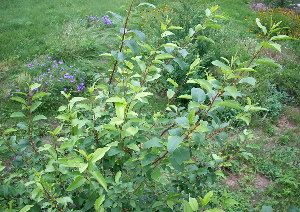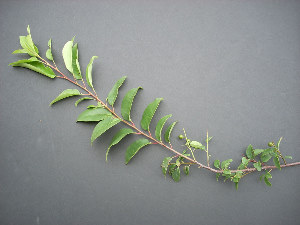Black Cherry, Southwestern Chokecherry, Escarpment Cherry
Prunus serotina Ehrh; Prunus serotina Ehrh. var. virens (Woot. & Standl.) McVaugh Prunus serotina Ehrh. var. eximia (Small)
Rosaceae (Rose Family)
Black cherry is a small-to-medium tree that sometimes grows to 60 feet in the eastern half of North America, it also occurs across most of the Great Plains and in the mountains of the southwest into the Chihuahuan and Sonoran Deserts of the United States and Mexico (Cox and Leslie 1988; Powell 1998; Young and Young 1992). Its somewhat toxic fruits and leaves were used variously for food, medicine, and stunning fish.
Archeological occurrence. Prunus serotina seeds and leaves were identified from Hinds Cave (Dering 1979). Based on radiocarbon dates from Hinds Cave, we have evidence for the use of black cherry fruit between 4,500 and 5,000 years ago in the Lower Pecos region.
Food. Black cherry was used as food by many groups living in the eastern half of North America, including the Cherokee, the Chippewa, the Menominee, the Ojibwa, the Potawatomi, as well as other western groups such as the Tepehuan of Chihuahua. A closely related variety, Prunus serotina var. capuli, was consumed by the Warihio of Sonora and Chihuahua (Gentry 1963:94).
In most cases food preparation was simple; either the fruits were eaten fresh, or they were dried for storage. However, Densmore (1928:321) reports that the Chippewa cooked the fruits without sugar, spread and dried the mass on birch bark, fashioned it into flatcakes, and stored them for winter use. Reagan (1928:235) noted that the Bois Fort Chippewa (Ojibwa) also crushed the fruit with the seed, dried and pounded it into a powder, and used the resulting flour in soups.
Black cherry was used as a beverage also; and the Ojibwa made an alcoholic drink from the fermenting fruits (Smith 1932:409). The Menominee also took advantage of the easily fermented fruits (Smith 1932). The Chippewa made a tea-like beverage out of the twigs, a point of interest because twig tea would have made a bitter and astringent drink more appropriate as a medicine (Densmore 1928:317).
Medicine. The fruits and leaves contain amygdalin which hydrolyzes in water to hydrocyanic acid, so they are somewhat toxic. In fact, the wilted leaves contain cyanic acid which is toxic to wildlife as well as livestock. Yet these potentially toxic compounds presented opportunities to healers, and black cherry was and continues to be widely used as a medicine. For several decades black cherry was listed in the National Formulary and the United States Pharmacopeia.
Black cherry is well known as a mild sedative or calming agent and for its antitussive qualities, and was used widely as a cough medicine or cold remedy. Groups using black cherry bark as a cold/cough remedy include the Chippewa, the Cherokee, the Delaware, Ojibwa, Micmac, and Penobscot. The Chippewa also treated tuberculosis with an infusion of the bark. The bark was utilized as a tea or infusion to treat stomach or intestinal ailments. Along these lines, when on the upper Missouri River, Captain Meriwether Lewis cured his own case of severe abdominal cramps by taking a mixture of choke cherry twigs boiled in water (Vogel 1970:389). Several groups used the inner bark (cambium) and the berries to treat diarrhea or worms, including the Menominees, the Chippewa, and the Cherokee.
Poultices of black cherry bark or root proved useful in treating various wounds or skin problems. The Chippewa applied a poultice of the inner bark to cuts, wounds, ulcers, and burns. Perhaps the most gruesome of these applications was the Menominee use of a cherry bark poultice that was applied after amputating a frozen extremity. The Cherokee used the bark to reduce fevers (Hamel and Chiltoskey 1975:28-29).
Other uses. Taking advantage of the toxic qualities of the bark, foliage, and wood of black cherry, the Tepehuan use the crushed leaves and twigs as a fish stupefaction agent (Pennington 1969). Cherry wood is strong and cuts cleanly (Flynn and Holder 2001:446), and the Warihio used the wood for tool handles (Gentry 1963: 95). Cherry wood is vulnerable to fungal attack, however, and as a result was not favored for outside use or use in building structures.
References:
Cox, Paul and Patty Leslie
1988 Texas Trees: A Friendly Guide. Corona Publishing Co. San Antonio, Texas.
Densmore, Francis
1928 Uses of Plants by the Chippewa Indians. Forty-fourth Annual Report of the Bureau of American Ethnology, Smithsonian Institution [1926-1927], pp. 275-397. Washington, D.C.
Dering, J. Philip
1979 Pollen and Plant Macrofossil Vegetation Record Recovered from Hinds Cave, Val Verde County, Texas. Unpublished Masters Thesis. Texas A&M University. College Station, Texas.
Flynn, James H. and Charles D. Holder
2001 A Guide to the Useful Woods of the World. Forest Products Society. Madison, Wisconsin.
Gentry, Howard S.
1963 The Warihio Indians of Sonora-Chihuahua: An Ethnographic Survey, Anthropological Paper No. 65. Smithsonian Institution Bureau of American Ethnological Bulletin No. 186. Anthropology Papers No. 63-65, pp. 61-144. U. S. Government Printing Office, Washington, D.C.
Hamel, Paul B. and Mary U. Chiltoskey
1975 Cherokee Plants and Their Uses -- A 400 Year History. Herald Publishing Co. Sylva, N.C.
Pennington, Campbell W.
1969 The Tepehuan of Chihuahua: Their Material Culture. University of Utah Press, Salt Lake City, Utah.
Powell, A. Michael
1998 Trees and Shrubs of the Trans-Pecos and Adjacent Areas. University of Texas Press. Austin, Texas.
Reagan Albert B.
1928 Plants Used by the Bois Fort Chippewa Indians of Minnesota. The Wisconsin Archeologist 7:230-248.
Smith, Huron H.
1923 Ethnobotany of the Menomini Indians. Bulletin of the Public Museum of Milwaukee 4:1-174.
1932 Ethnobotany of the Ojibwe Indians. Bulletin of the Public Museum of Milwaukee 4:327-525.
Vogel, Virgil
1970 American Indian Medicine. University of Oklahoma Press. Norman, Oklahoma.
Young, James A. and Cheryl G. Young
1992 Seeds of Woody Plants in North America. Disocorides Press. Portland, Oregon.
![]()

